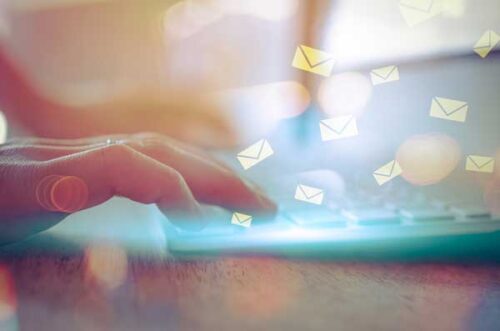4 Marketing Emails You Can Set and Forget (At Least for a While)
Have you tried to write any handwritten notes lately? I swear, my fingers are so used to taking the shape of a keyboard instead of a pencil that the act of penning a single card makes my knuckles creak.
That’s not to say the thousands upon thousands of words I type every day aren’t also taking their toll. The average email user sends 34 emails per day (and gets back 88), but those numbers include people in every role and industry, not to mention children. I bet if you gathered up the stats on marketers and salespeople alone that number would be … I don’t want to think about it.
Thankfully, certain tools have come to the rescue of our cramped fingers … ergonomic wrist pads, laptop risers, and oh, marketing automation.
Marketing automation presents the single easiest solution to the burdensome effect email can have on a marketer’s time. Because yes, it’s essential that we stay in contact with our leads and customers, but that doesn’t mean we need to be pressing send hundreds of times per day.
Here are four emails you can put into your automation program, set, and forget (at least for now).
1. Your Welcome Email
Think about walking into your favorite storefront or restaurant. Chances are, you recieve a warm welcome from an employee when you walk in the door. They might say the same exact phrase 100 times a day to their customers, but when they say it to you, you feel most welcomed.
Digital experiences are the same. Storefront or no, your customers need to be welcomed. Set up an automated email that’s triggered within minutes of someone subscribing to your email list or requesting more information. Like a restaurant server visiting your dining table for the first time, it should present all the relevant information — gratitude for showing up, who you are, what they can expect from you (type of content, frequency of contact), as well as the showcase of a little personality. And don’t forget dessert: consider presenting a relevant link to a tidbit of further information they might be interested in. Keep it light.
2. Reminders That Simplify Their Lives
Your customers are busy people. And do you know what busy people appreciate? Someone doing things for them. Use your marketing automation software to set and forget triggered reminders to customers at useful times in their buyer or retention journey. For example, you could remind them when a subscription is up for renewal, when their credit card is going to expire, when they’ve abandoned something in their cart for a set amount of days, or when you have a sale or special going on.
Think of yourself as their virtual personal assistant and consider what types of things they would want on their calendar that you can remind them of via email instead.
3. Thank You Emails
Saying thanks is one of the first social-emotional skills many of us learn as kids. And there is a reason beyond politeness that we do it. In a psychological study, people who received a note of thanks after performing a favor were more likely to volunteer to help the same person again then those who received a neutral note of reply. It’s the gratitude effect: and you need to be using it in your marketing emails.Set-up automated thank you emails for any task that you want leads or customer to take (you know, the ones you report analytics on to your bosses?) — it could be for downloading a white paper, talking to a rep, recommending you to a friend, making a purchase, or even just spending an extended time clicking around your products or services. A little gratitude will go a long way.
4. Requests for Feedback
Surveys and requests for feedback serve two purposes. First, they help you understand what your team or products is nailing and where you’re falling short. Second, it builds goodwill with your audience. When we ask people for their input, the requested advisor actually receives a boost of confidence that in turn, makes them think more highly of the person or organization asking for that advice.
Create at least two versions of a survey — one for customers who complete the buyer journey and make a purchase, and one for leads who were close to buy in but didn’t seal the deal. Put them in an email that’s triggered by the final decision process, and watch the answers roll in. With the closed business, you may want to include a question to get net promoter score (NPS). The NPS asks how likely, on a scale of 0-10, the customer is to recommend you to a friend. Scores from 9-10 are promoters, and (bonus email!) may indicate you should send an automated request for a recommendation or online review.
It’s important to address a disclaimer. Yes, you can set and forget these emails, but only for a little while. Set your own reminders to check in and ensure the content you’re using is still fresh. You’ll also want to monitor your analytics for any major changes in engagement rates that may indicate time for an update. And you can also take easy, quick actions to continue to optimize such as running A/B tests on an automated email subject line or placement of the CTA inside. Otherwise, give your weary fingers a rest and let marketing automation take over.
——-
Taylor Burke is a contributor for TechnologyAdvice.com. She’s passionate about marketing and great customer experiences. When she’s not in front of her screen, you can find Taylor reading, cooking, running, or hanging with her dog—but rarely all four at once. Connect with her on LinkedIn.
Schedule a demo
Schedule a meeting with our partner development team. Let us know the best time to connect, and we’ll show you what’s possible to achieve in a live demo.


6399 San Ignacio Avenue
Second Floor
San Jose, CA 95119
Toll Free +1 800 858 8500
Main +1 408 490 2900
© eTrigue Corporation | Privacy Policy | Acceptable Use | Legal Notices | Privacy Shield | GDPR | DPA | Send Files
